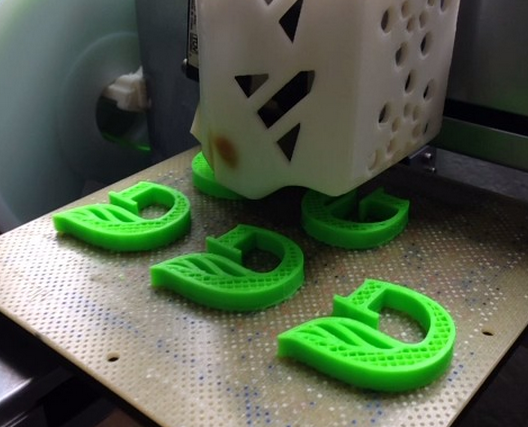Yesterday I launched a component of the Green Party’s smart green innovation package, Blueprint for the Future – a digital manufacturing strategy for New Zealand. It deals with a range of technologies but the most notable, disruptive, and headline grabbing is 3D printing.
My personal interest in 3D printing started about a year ago. I had read a bit about 3D printing on blogs and websites but it wasn’t until I heard Maurice Williamson talking on the radio of the risks of 3D printing drugs and guns at parties and then going on about printing gems and gold that I thought we need a more informed public discussion and that I had to research this issue further. So I tried to meet as many experts and makers as possible to understand the technology further. I toured the maker spaces around New Zealand like the Wellington Maker Space where we launched the package today, met with academics and experts at the universities and with business cooperatives like the Titanium Industry Development association (TIDA) in Tauranga. I read as much as I could about it and was struck that The Economist would describe it as maybe having as profound an impact on the world as the coming of the factory did. I even started an MIT Fab Lab night course at Massey University.
I learnt about the amazing developments here in New Zealand. Many wouldn’t know New Zealand has the world’s second largest 3D printing services bureau based here in Wellington, Ponoko, or that Victoria University’s student Jake Evill recently won a global design award for his 3D printed lattice cast for broken arms, or about the printed titanium products being exported from TIDA in Tauranga. What I saw was an economic opportunity for New Zealand. With our manufacturing sector in decline over the last few decades this was a chance to embrace new manufacturing technologies and innovation and grow good new jobs. New Zealand could never compete with Chinese or Indian factories for mass-producing low-cost products but we can win if we focus on high-value, advanced products and associated services.
3D printing, also called additive manufacturing, is a process of creating three-dimensional objects in a variety of materials using a computer-aided design (CAD) digital file. Other digital manufacturing technologies including laser-cutting, CNC milling and digital textiles production incorporate elements similar to 3D printing. Unlike traditional subtractive manufacturing processes 3D printing is an additive technology that builds the object ‘piece by piece’ from a digital design with an X-Y-Z axis printer. A broad range of materials can be printed ranging from plastics, metals such as titanium, clay, concrete, chocolate and even living embryonic stem cells.
3D printing has a number of advantages over traditional manufacturing techniques in areas such as customisation, rapid prototyping and printing ‘layer by layer’ allows incredible complexity and detail. It is a green technology in the sense it massively reduces input materials, waste and shipping products around the world.
3D printing has seen phenomenal growth in the last few years and the UK Government has estimated it could be a $100b market by 2020. It’s a great opportunity for New Zealand, with our real ICT and design strengths and our distance from export markets. New Zealand however doesn’t have a national additive manufacturing or digital manufacturing strategy and only small research and development support through the NZ Product Accelerator and Callaghan. The Customs Department is investigating 3D printing as a border security threat but New Zealand also needs to consider it as an economic opportunity. Some schools like Scots College have a new $15m technology block with 3D printers but our Ministry of Education don’t know how many other schools have printers for their students to familiarise themselves.
Looking around the world, it has received the support of the President Obama who featured it in his state of the union address last year and invested $200m including creating a National Additive Manufacturing Innovation Institute, symbolically in a disused factory. China, Singapore, South Africa, the UK and Australian states are all investing significant resources and attention in 3D printing but New Zealand lacks a strategy or leadership.
New Zealand has a real opportunity to support our manufacturing sector and provide national leadership in this emerging disruptive technology. As the late professor Paul Callaghan said, New Zealand’s path to prosperity lies in technology niches, and 3D printing offers a growing economic niche for the country. Other countries are clearly investing significant sums into this technology and it is important New Zealand does not miss out. The Green Party in Government will establish a Digital Manufacturing Taskforce to investigate the opportunities, identify any gaps or barriers, recommend how to encourage digital manufacturing and investigate regulatory and intellectual property implications. We will develop a national Digital Manufacturing Strategy to help grow Kiwi jobs and exports. It’s another example how the Greens are showing leadership for a smart green innovative economy – growing a richer New Zealand.






You do realise the plastics used from 3D printing come from oil and the metals from mining? How does this fit in with the fact that the Greens are opposed to oil exploration and drilling?
Not necessarily. Many consumer orientated 3D printers actually print with PLA, which is made entirely from renewable resources. http://en.wikipedia.org/wiki/Polylactic_acid
The metals could also be sourced from recycled material not JUST mining.
not everything in 3D printing is made in plastic
look at ponoko’s website to see the variety of materials available
Think of the insane amounts of raw material it takes to set up an assembly line that creates all the different components or pieces of the goods we buy, and the effort required to refit those assembly lines when a new or modified product is required. Compare that to 3D printing, which is a lot less resource intensive, as the one machine can create so many different kinds of products, and only the software file needs to be changed. It is a vastly superior form of production in terms of setup and resources.
Stephen, exploiting and using oil isn’t intrinsically bad.
It depends on its use.
Merely burning oil is foolish in the longer term. Burning depletes the valuable non renewable resource for short term gain and releases GHG which are of major concern for our future.
Manufacturing and plastics do not suffer the same carbon footprint and their main environmental problems involve disposal i.e plastics pollution, which can be mitigated by recycling, education and modifying consumer behaviour.
Manufacturing ANYTHING is unsustainable, including 3D printers.
The greeds need to go to the moon and look back, see that self contained object (Earth) that is what is commonly called a closed system. or finite, you can not continue to grow (smart or dumb) in a finite world, something has to give, ie the environment. Specifically your children’s.
I know to much truth again, will not get published …. ho hum
If we wanted to move to a lower water-use food production system like, say, aquaponics – how would you prefer the pumps to be made? By traditional manufacturing or 3D printing?
We’re not going to get from unsustainable to sustainable in one giant step.
And we won’t get there in one step for two reasons:
1. The technology jump is too big.
2. People won’t get their heads around it – it’s perceived as loss/change/different. That’s the real barrier.
That’s utter codswallop Robert. Mankind has been manufacturing things since before recorded history. We can continue to manufacture things including cellphones and TVs but we have to be very, very strict on the replacement cycles, recycling and using renewable energy.
This is a brilliant approach – not so long into the future we will have the chance to print almost anything we use (for actual use) – this can be one way of getting past greedy corporations and if we have our government protecting this technology for us all to use, then we have the potential to help deal with and prevent poverty in our country, as well as environmental exploitation. Keep this up Gareth.
I see so many oppotunities with 3D printing. It makes it easy to make a prototype but i still think we have to wait some years before it gets cheap and easy to use.. I guess..
There is some very interesting negative voting going on against these comments. Who would have thought that 3D printing could be so contentious?
Obviously it’s got a lot going for it.
3D printing is definitely the next big thing and it’s very pleasing to see the Greens pick this up.
It’s a very “green” technology – manufacture at the point of need/use so reducing transport costs and the waste of unused/unsold manufactured products. Obviously you have to have materials at the printer, but they are available for many purposes.
Also fits with the idea of weightless exports – perfect for our location.
It also puts sculptors out of work. We could stop buying imported crap, amongst other strategies.
I’m pretty sure that iPads and iPhones aren’t low cost products and that we could easily compete in producing similar products – especially if we used 3D Manufacturing. We could even compete in designing them but doing so is going to require a massive shift education thinking. Essentially, the government would have to take on as policy that people are either in work or in training. There would be no unemployed.
That is where government comes ins. The government provides funding, and even direction, for the research. It can also build the manufacturies to get the innovation started – just as the US government built the first micro-fab plants in Silicon Valley. The US government also provided most of the funding for the research that led to the development of the semi-conductor and the silicon chip as well for that matter. The big problem that the US government did was not to have proper licensing in place which meant that companies such as Apple made huge profits but didn’t pay for any of the work that allowed them to make huge profits.
3D Printing will kill capitalism and international trade. Multinational corporations won’t be able to keep up with the manufacturing capabilities of millions of tiny manufacturing plants in each country that produce anything that people can design. All of that is the true golden opportunity of 3D Printing.
Providing the TPPA doesn’t put a clamp on the IP to severely limit it.
Are there corporations out there currently madly getting (generic) patents on 3D designs and 3D printing methods?
Wouldn’t be surprised.
One answer to that though is to ignore the patents due to prior art. <a href="http://en.wikipedia.org/wiki/3D_printing"3D printing has been around for a lot longer than most people realise and any patents on it have long since expired.
Another, more rational answer, would be to treat patents as non-exclusive. This would mean that patent holder would have to prove that someone else actually copied their design. Most importantly though it would allow people to develop their own ideas rather than being constrained by outside forces as they are now.
Well done Gareth another reason i switched my vote from labour to greens a year ago.
Comments are closed.